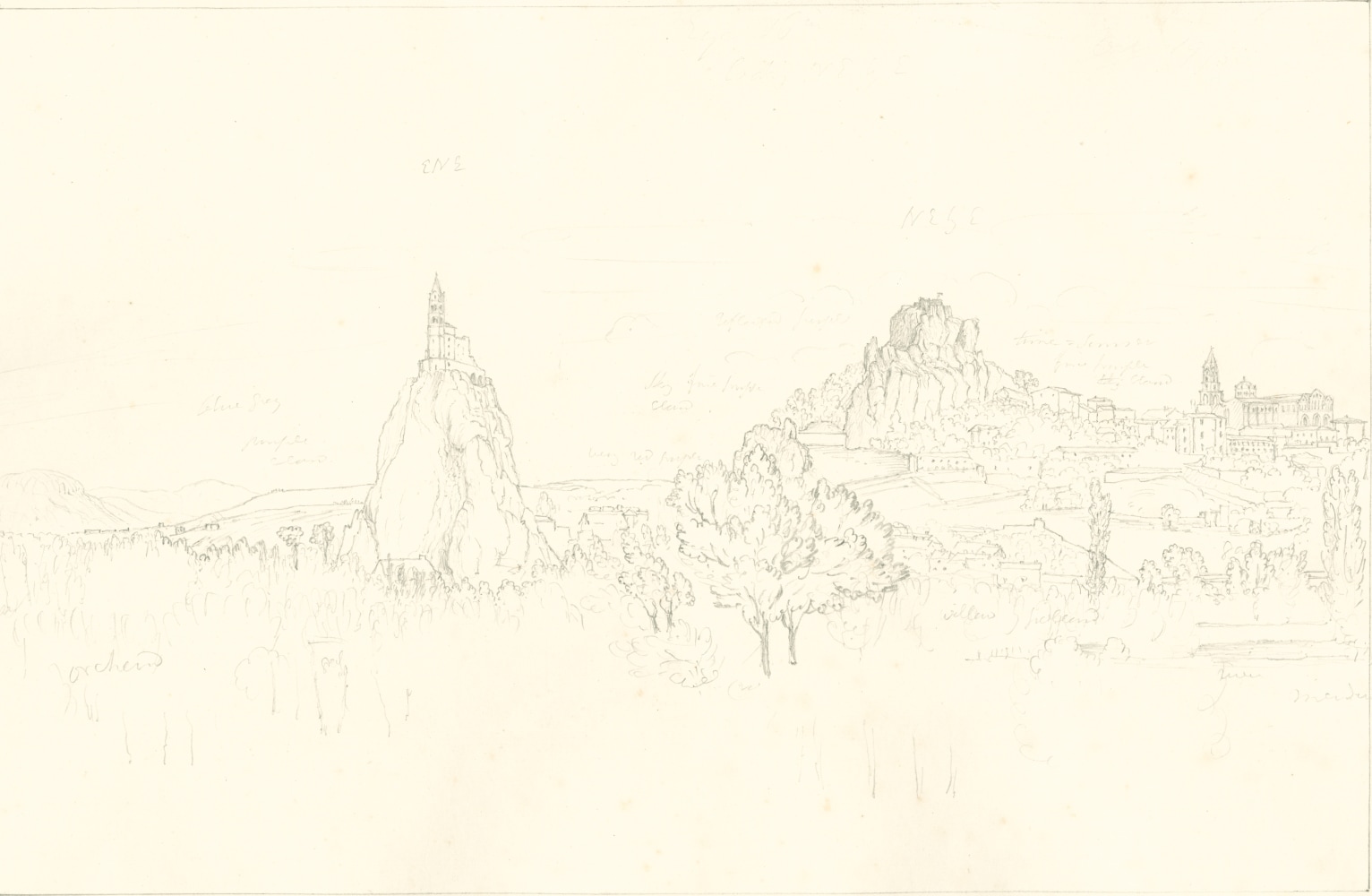
Sir John Frederick William Herschel (English, 1792-1872)
"No 495 Le Puy. From across the bridge. The Church of St Michel, The Rocher du Corneille & the Cathedral”, 19 October 1850
Camera lucida drawing, pencil on paper
21.6 x 33.3 cm on 25.2 x 38.5 cm paper
Numbered, signed, dated and titled “No 495 / JFW Herschel del. Cam. Luc. Oct. 19, 1850 / Le Puy. From across the bridge. The Church of St Michel bearing ENE, The Rocher du Corneille NE by E. / (by compass) & the Cathedral” in ink in border
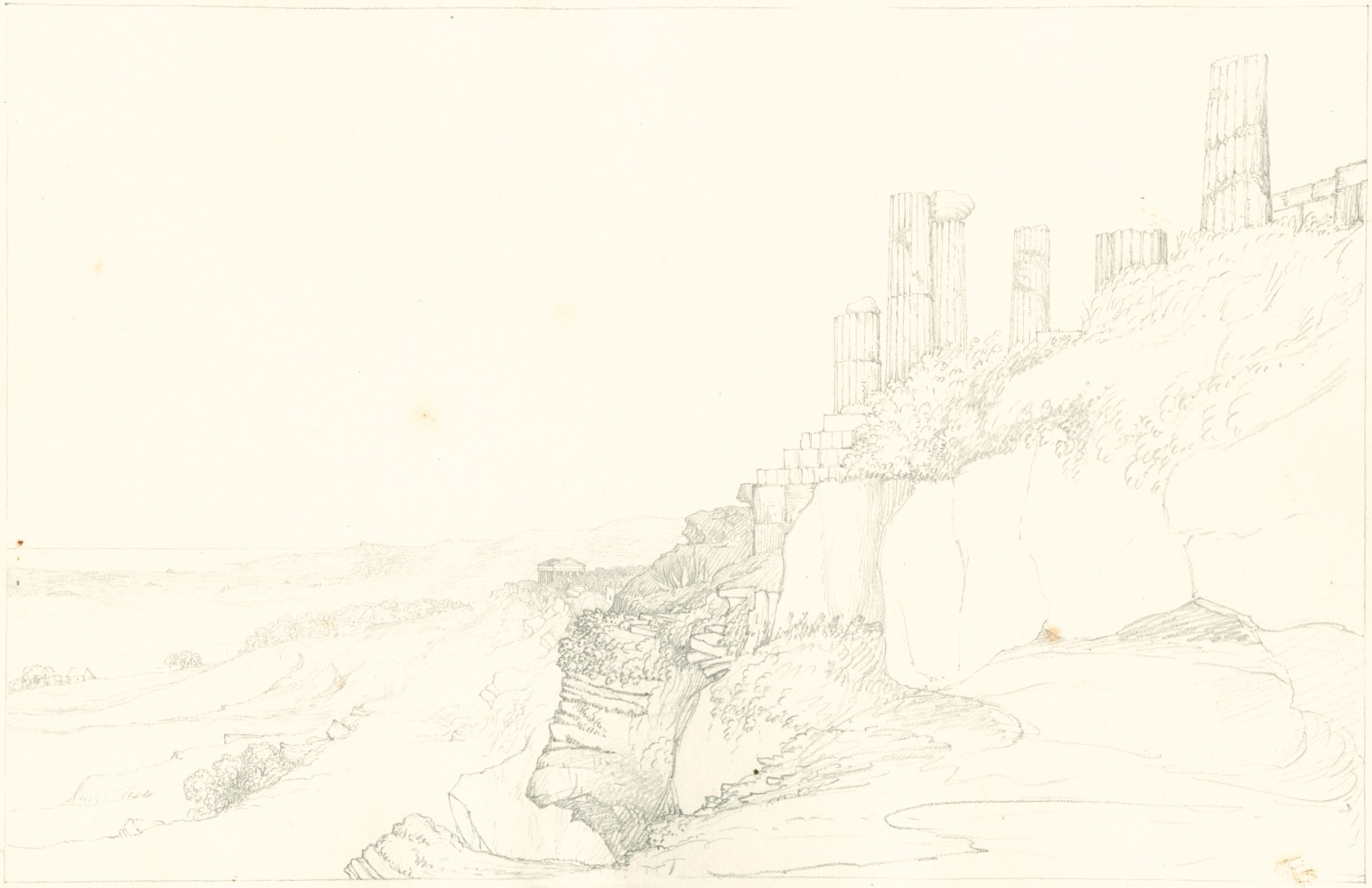
Sir John Frederick William Herschel (English, 1792-1872)
"No 391 View from below the Temple of Juno, Girgenti Sicily. Temple of Concord in the distance”, 27 June 1824
Camera lucida drawing, pencil on paper
20.0 x 31.0 cm on 25.1 x 38.4 cm paper
Numbered, signed, dated and titled “No 391 / JFW Herschel del Cam Luc. June 27, 1824. / View from below the Temple of Juno. Girgenti Sicily. Temple of Concord in the distance” in ink in border, and “Concord / 36. Temple of [crossed out] seen from / [illegible] of Juno Girgenti” in pencilHerschel told his mother that he found it "a most curious place & full of ruins the Rocks being all honeycombed with houses &c and the Temples superb. I have crammed my drawing cases with views of them."1 To Sir William Watson, however, he was more philosophical: "the ruins of ancient Agrigentum... stand now far aloof from the modern town wh has retreated from ye pestilential influence of ye air to ye summit of a hill 2 or 3 miles off. It is incredible what an awful air this circumstance gives them. One must be on ye spot to feel its full effect. It seems as if they were preserved as monuments of wrath as if the curse which devastated still clove to them & caused them to be at once admired & shunned. It is indeed the beauty of desolation, for finer architectural remains can hardly be imagined."2 In 1928, Girgenti reverted to its classical name of Agrigentum.
Herschel told his mother that he found it "a most curious place & full of ruins the Rocks being all honeycombed with houses &c and the Temples superb. I have crammed my drawing cases with views of them."1 To Sir William Watson, however, he was more philosophical: "the ruins of ancient Agrigentum... stand now far aloof from the modern town wh has retreated from ye pestilential influence of ye air to ye summit of a hill 2 or 3 miles off. It is incredible what an awful air this circumstance gives them. One must be on ye spot to feel its full effect. It seems as if they were preserved as monuments of wrath as if the curse which devastated still clove to them & caused them to be at once admired & shunned. It is indeed the beauty of desolation, for finer architectural remains can hardly be imagined."2 In 1928, Girgenti reverted to its classical name of Agrigentum.
1Letter, Herschel to his mother, from Catania, 1 July 1824. LO517, Herschel collection, the Humanities Research Center, The University of Texas at Austin.
2Letter, Herschel to Watson, from Palermo, 16 July 1824. LO494. Herschel Collection, the Humanities Research Center, The University of Texas at Austin.

Sir John Frederick William Herschel (English, 1792-1872)
"No 557 Worcester Cathedral”, 1829
Camera lucida drawing, pencil on paper
20.2 x 32.2 cm on 24.4 x 38.5 cm paper
Watermark “J Whatman Turkey Mill”. Numbered, signed, dated and titled “No 557 / JFW Herschel delin Cam. Luc. / 1829 / Worcester Cathedral” in ink in border. Titled “Worcester” in pencil on verso
The great scientist Sir John Herschel proved himself gifted at drawing while still a schoolboy. The camera lucida raised his technical skills to new heights while his artistic talent translated them into precise and often beautiful drawings. While many artists of the time used the camera lucida, Herschel used it more successfully than his contemporaries. His camera lucida drawing of Worcester Cathedral is signed, titled, and dated by Herschel in ink. Situated on a bank overlooking the River Severn, Worcester Cathedral was built between 1084 and 1504 and is noteworthy for the many styles of English architecture in which it was constructed.
The overwhelming majority of Herschel's camera lucida drawings are now in public collections; only a few are known to remain in private collections.
Inquire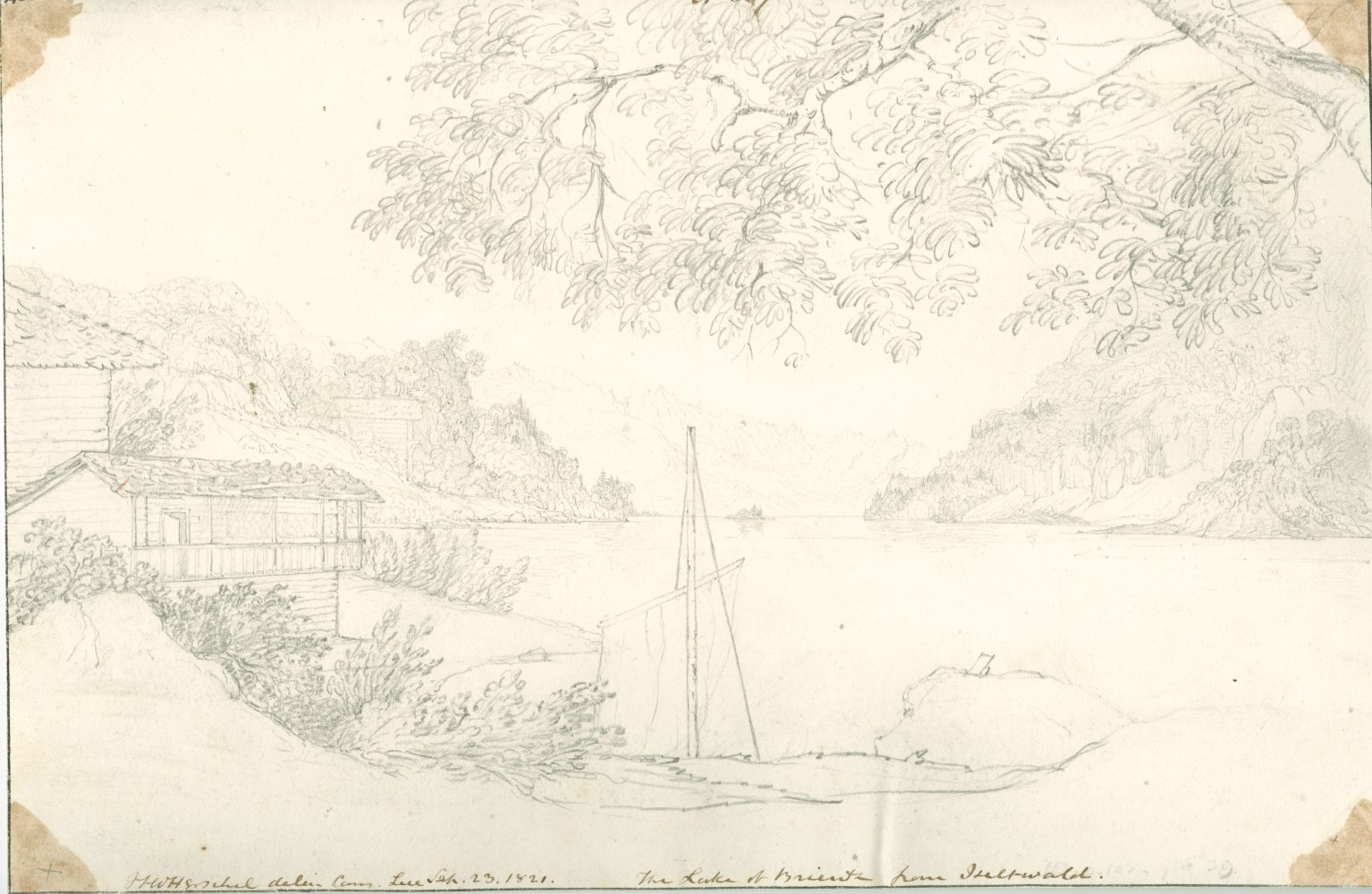
Sir John Frederick William Herschel (English, 1792-1872)
"No 507 The Lake of Brienz from Iseltwald”, 23 September 1821
Camera lucida drawing, pencil on paper
20.3 x 30.6 cm
Numbered, signed, dated and titled “No 507 / JFW Herschel delin. Cam. Luc. / Sep. 23, 1821. / The Lake of Brienz from Iseltwald.” in ink. Inscribed “Iseltwald” two times in pencil on verso
Sir John, along with his wife, daughters and friends, based paintings on his original camera lucida drawings. In 1844 he wrote to a friend: "thank you for the very, very sweet picture you have created our of my poor sketch of Iseltwald, which brings back the scene in so lively a manner that it makes 20 years disappear and I can fancy myself just disembarking from the old flap sailed boat among the merry groupe you have inserted in your foreground... I hope you will not hesitate to make use of any of the subjects in my portfolio which will at all times be at your command."1
1 Notebook, JFWH's Tour in France 1821 July 21st to Aug 31st. W0054, Herschel Collection, the Humanities Research Center, The University of Texas at Austin
Inquire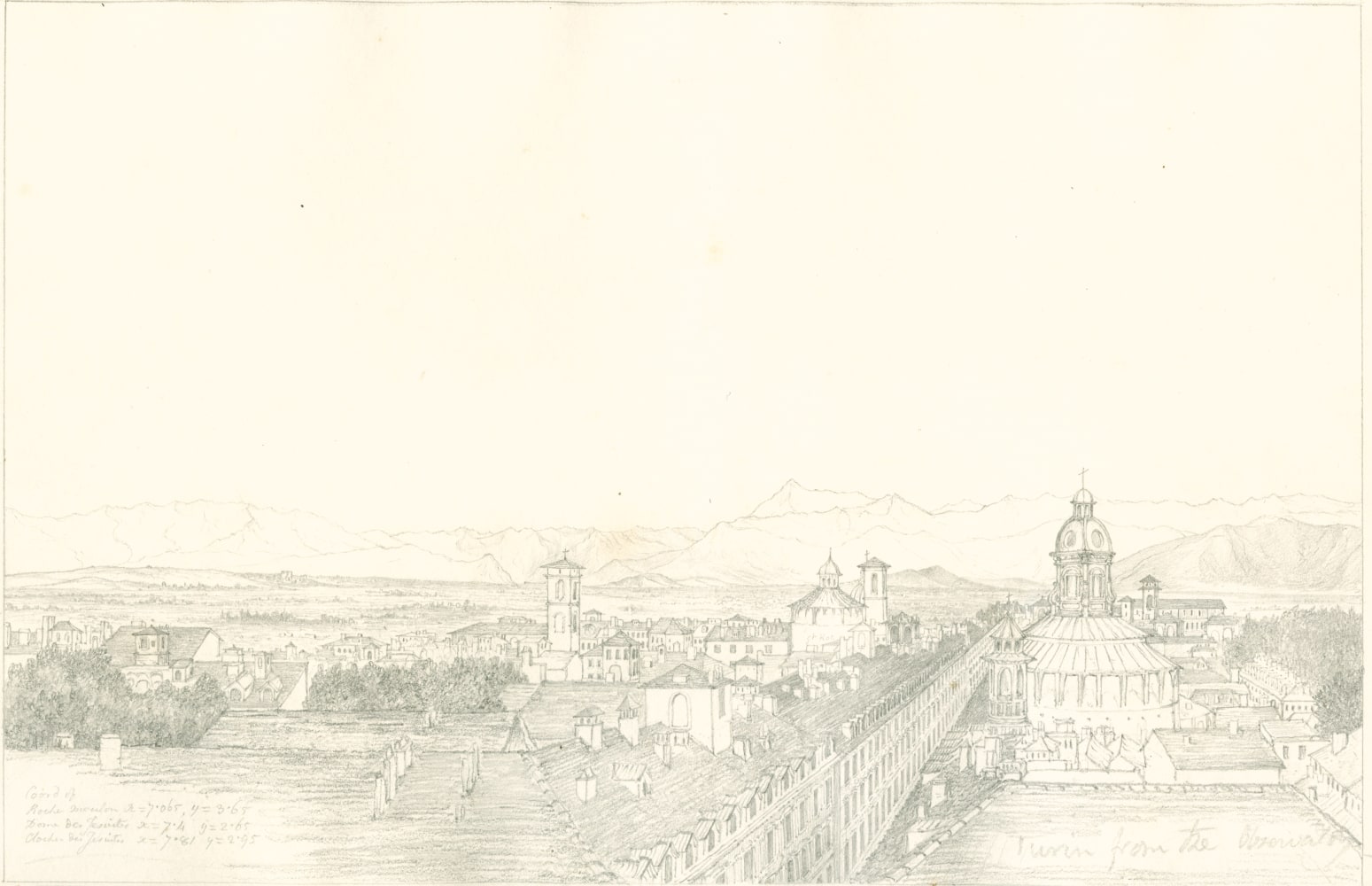
Sir John Frederick William Herschel (English, 1792-1872)
"No 351 Turin with the chain of the Alps. From the roof of the Observatory”, 1824
Camera lucida drawing, pencil on paper
20.2 x 31.0 cm on 25.2 x 38.6 cm paper
Numbered, signed, dated and titled “No 351 / JFW Herchel del. Cam. Luc. / 1824 / Turin with the chain of the Alps. From the roof of the Observatory.” in ink in border, and “Coord of / Roche Moulon x = 7.065, y = 3.65 / Dome des Jesuites x = 7.4, y = 2.65 / Clocher des Jesuites x = 7.81, y = 2.95 / Turin from the Observatory” in pencil. Inscribed “Turin from Observatory” in pencil on verso
Herschel, now travelling with just a servant on his second Grand Tour, wrote to his friend Charles Babbage that "the view of the Alps from the observatory Roof at Turin... is the finest thing conceivable we missed this when we were there together... this is the most delicious spot on earth as you would say if you saw it in such weather & were enjoying there the luxury of repose, good feeding, & pleasant society after crossing Mr. Cenis in the snow and being at once scorched & frozen & buried alive." To his mother, he enthused that "the glorious spectacle of the Alps which surround the town like a bulwark of ice at the distance of fifty to a hundred miles... is the finest sight in the world;" he promised that "you shall see a drawing of it I took from the top of the Observatory yesterday."
Inquire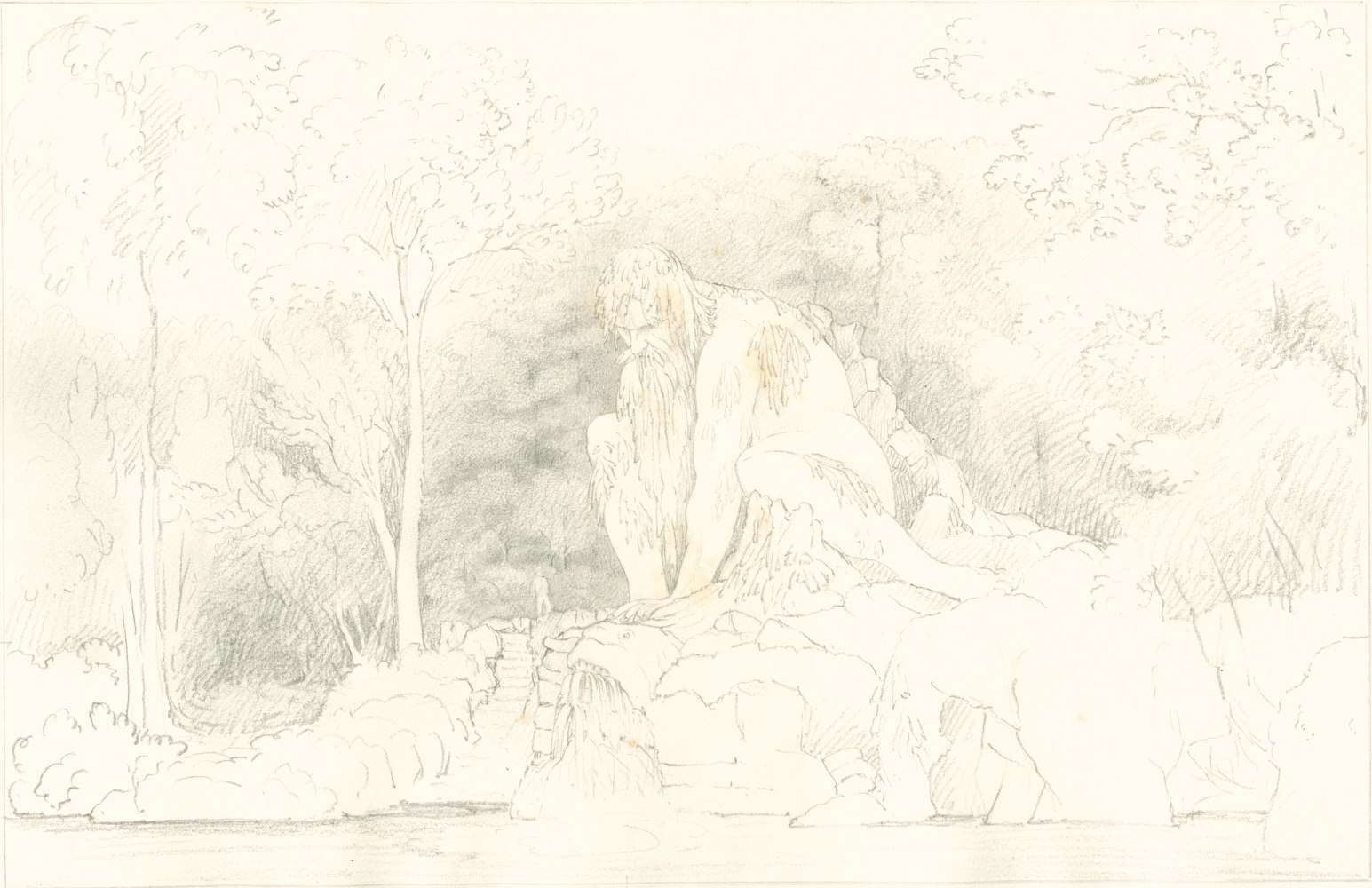
Sir John Frederick William Herschel (English, 1792-1872)
"No 358 Colossal Statue ‘Father Apennine’ by John of Bologna in the Grand-ducal garden of Pratolino near Florence” , 1824
Camera lucida drawing, pencil on paper
20.0 x 30.9 cm on 25.3 x 38.8 cm paper
Numbered, signed, dated and titled “No 358 / JFW Herschel del Cam. Luc. / 1824. / Colossal Statue / ‘Father Apennine’ by John of Bologna in Grand-ducal garden of Pratolino near Florence.” in ink in border. Inscribed “Pratolino” in pencil on verso
Herschel found this a "very extraordinary... hoary giant shaggy with icicles which descent from his hair and beard and bowed with a weight of snow... it is finely imagined and of enormous magnitude, as you will easily suppose when I tell you I climbed into his head through a gallery hollowed out in his throat. There is a tolerable representation of this figure in the 'hundred wonders' but the situation of it there is supplied from fancy being quite different from reality. I returned to Florence from this excursion... desperately tired, though much gratified, and exclaiming against Italian heat -- Italian dust -- Italian mules -- and Italian hunger (having been near nine hours on foot). While poor James [his servant, James Child], who carried my drawing apparatus and some other necessary implements, was quite done up."
Inquire
Sir John Frederick William Herschel (English, 1792-1872)
"No 495 Le Puy. From across the bridge. The Church of St Michel, The Rocher du Corneille & the Cathedral”, 19 October 1850
Camera lucida drawing, pencil on paper
21.6 x 33.3 cm on 25.2 x 38.5 cm paper
Numbered, signed, dated and titled “No 495 / JFW Herschel del. Cam. Luc. Oct. 19, 1850 / Le Puy. From across the bridge. The Church of St Michel bearing ENE, The Rocher du Corneille NE by E. / (by compass) & the Cathedral” in ink in border

Sir John Frederick William Herschel (English, 1792-1872)
"No 391 View from below the Temple of Juno, Girgenti Sicily. Temple of Concord in the distance”, 27 June 1824
Camera lucida drawing, pencil on paper
20.0 x 31.0 cm on 25.1 x 38.4 cm paper
Numbered, signed, dated and titled “No 391 / JFW Herschel del Cam Luc. June 27, 1824. / View from below the Temple of Juno. Girgenti Sicily. Temple of Concord in the distance” in ink in border, and “Concord / 36. Temple of [crossed out] seen from / [illegible] of Juno Girgenti” in pencilHerschel told his mother that he found it "a most curious place & full of ruins the Rocks being all honeycombed with houses &c and the Temples superb. I have crammed my drawing cases with views of them."1 To Sir William Watson, however, he was more philosophical: "the ruins of ancient Agrigentum... stand now far aloof from the modern town wh has retreated from ye pestilential influence of ye air to ye summit of a hill 2 or 3 miles off. It is incredible what an awful air this circumstance gives them. One must be on ye spot to feel its full effect. It seems as if they were preserved as monuments of wrath as if the curse which devastated still clove to them & caused them to be at once admired & shunned. It is indeed the beauty of desolation, for finer architectural remains can hardly be imagined."2 In 1928, Girgenti reverted to its classical name of Agrigentum.
Herschel told his mother that he found it "a most curious place & full of ruins the Rocks being all honeycombed with houses &c and the Temples superb. I have crammed my drawing cases with views of them."1 To Sir William Watson, however, he was more philosophical: "the ruins of ancient Agrigentum... stand now far aloof from the modern town wh has retreated from ye pestilential influence of ye air to ye summit of a hill 2 or 3 miles off. It is incredible what an awful air this circumstance gives them. One must be on ye spot to feel its full effect. It seems as if they were preserved as monuments of wrath as if the curse which devastated still clove to them & caused them to be at once admired & shunned. It is indeed the beauty of desolation, for finer architectural remains can hardly be imagined."2 In 1928, Girgenti reverted to its classical name of Agrigentum.
1Letter, Herschel to his mother, from Catania, 1 July 1824. LO517, Herschel collection, the Humanities Research Center, The University of Texas at Austin.
2Letter, Herschel to Watson, from Palermo, 16 July 1824. LO494. Herschel Collection, the Humanities Research Center, The University of Texas at Austin.
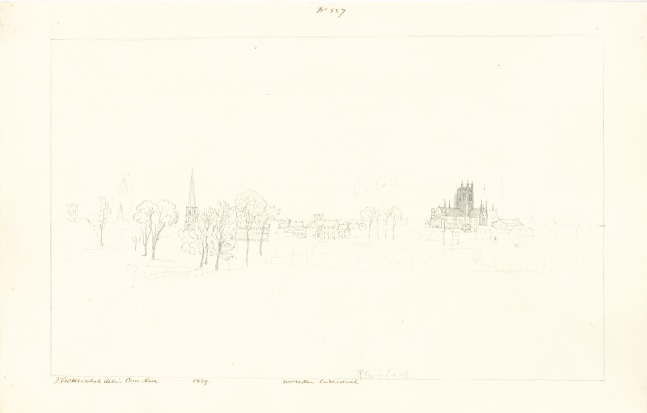
Sir John Frederick William Herschel (English, 1792-1872)
"No 557 Worcester Cathedral”, 1829
Camera lucida drawing, pencil on paper
20.2 x 32.2 cm on 24.4 x 38.5 cm paper
Watermark “J Whatman Turkey Mill”. Numbered, signed, dated and titled “No 557 / JFW Herschel delin Cam. Luc. / 1829 / Worcester Cathedral” in ink in border. Titled “Worcester” in pencil on verso
The great scientist Sir John Herschel proved himself gifted at drawing while still a schoolboy. The camera lucida raised his technical skills to new heights while his artistic talent translated them into precise and often beautiful drawings. While many artists of the time used the camera lucida, Herschel used it more successfully than his contemporaries. His camera lucida drawing of Worcester Cathedral is signed, titled, and dated by Herschel in ink. Situated on a bank overlooking the River Severn, Worcester Cathedral was built between 1084 and 1504 and is noteworthy for the many styles of English architecture in which it was constructed.
The overwhelming majority of Herschel's camera lucida drawings are now in public collections; only a few are known to remain in private collections.

Sir John Frederick William Herschel (English, 1792-1872)
"No 507 The Lake of Brienz from Iseltwald”, 23 September 1821
Camera lucida drawing, pencil on paper
20.3 x 30.6 cm
Numbered, signed, dated and titled “No 507 / JFW Herschel delin. Cam. Luc. / Sep. 23, 1821. / The Lake of Brienz from Iseltwald.” in ink. Inscribed “Iseltwald” two times in pencil on verso
Sir John, along with his wife, daughters and friends, based paintings on his original camera lucida drawings. In 1844 he wrote to a friend: "thank you for the very, very sweet picture you have created our of my poor sketch of Iseltwald, which brings back the scene in so lively a manner that it makes 20 years disappear and I can fancy myself just disembarking from the old flap sailed boat among the merry groupe you have inserted in your foreground... I hope you will not hesitate to make use of any of the subjects in my portfolio which will at all times be at your command."1
1 Notebook, JFWH's Tour in France 1821 July 21st to Aug 31st. W0054, Herschel Collection, the Humanities Research Center, The University of Texas at Austin

Sir John Frederick William Herschel (English, 1792-1872)
"No 351 Turin with the chain of the Alps. From the roof of the Observatory”, 1824
Camera lucida drawing, pencil on paper
20.2 x 31.0 cm on 25.2 x 38.6 cm paper
Numbered, signed, dated and titled “No 351 / JFW Herchel del. Cam. Luc. / 1824 / Turin with the chain of the Alps. From the roof of the Observatory.” in ink in border, and “Coord of / Roche Moulon x = 7.065, y = 3.65 / Dome des Jesuites x = 7.4, y = 2.65 / Clocher des Jesuites x = 7.81, y = 2.95 / Turin from the Observatory” in pencil. Inscribed “Turin from Observatory” in pencil on verso
Herschel, now travelling with just a servant on his second Grand Tour, wrote to his friend Charles Babbage that "the view of the Alps from the observatory Roof at Turin... is the finest thing conceivable we missed this when we were there together... this is the most delicious spot on earth as you would say if you saw it in such weather & were enjoying there the luxury of repose, good feeding, & pleasant society after crossing Mr. Cenis in the snow and being at once scorched & frozen & buried alive." To his mother, he enthused that "the glorious spectacle of the Alps which surround the town like a bulwark of ice at the distance of fifty to a hundred miles... is the finest sight in the world;" he promised that "you shall see a drawing of it I took from the top of the Observatory yesterday."

Sir John Frederick William Herschel (English, 1792-1872)
"No 358 Colossal Statue ‘Father Apennine’ by John of Bologna in the Grand-ducal garden of Pratolino near Florence” , 1824
Camera lucida drawing, pencil on paper
20.0 x 30.9 cm on 25.3 x 38.8 cm paper
Numbered, signed, dated and titled “No 358 / JFW Herschel del Cam. Luc. / 1824. / Colossal Statue / ‘Father Apennine’ by John of Bologna in Grand-ducal garden of Pratolino near Florence.” in ink in border. Inscribed “Pratolino” in pencil on verso
Herschel found this a "very extraordinary... hoary giant shaggy with icicles which descent from his hair and beard and bowed with a weight of snow... it is finely imagined and of enormous magnitude, as you will easily suppose when I tell you I climbed into his head through a gallery hollowed out in his throat. There is a tolerable representation of this figure in the 'hundred wonders' but the situation of it there is supplied from fancy being quite different from reality. I returned to Florence from this excursion... desperately tired, though much gratified, and exclaiming against Italian heat -- Italian dust -- Italian mules -- and Italian hunger (having been near nine hours on foot). While poor James [his servant, James Child], who carried my drawing apparatus and some other necessary implements, was quite done up."
